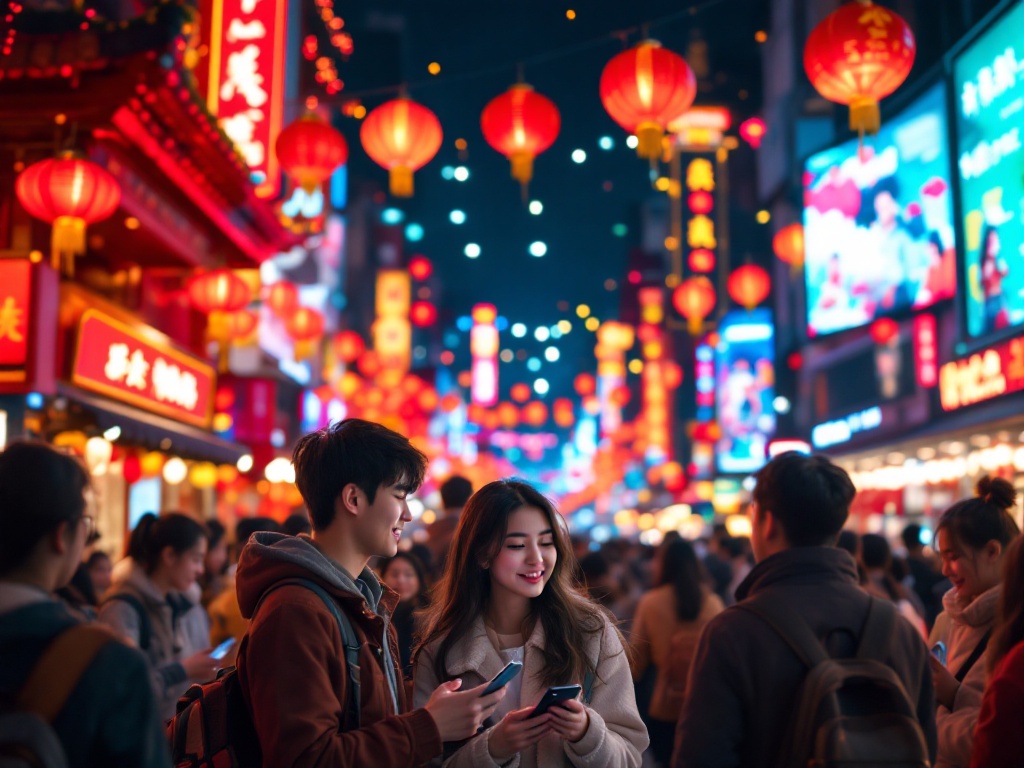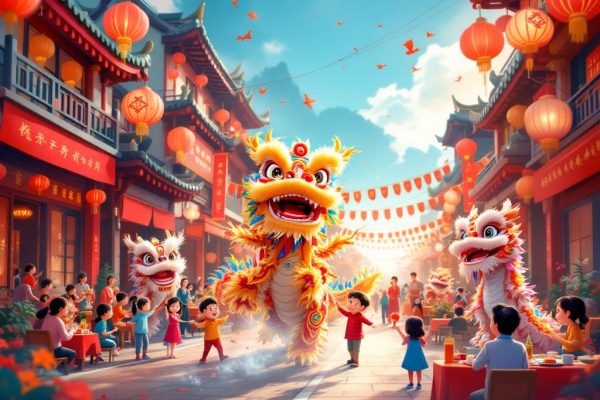Connecting in China: Chinese Social Media Trends and Culture
Unlock the secrets of China’s booming social media landscape! Discover how platforms like WeChat, Weibo, and Douyin (TikTok) are transforming Chinese culture and commerce, especially during key events like Chinese New Year. Learn how these platforms are reshaping consumer behavior, influencing purchasing decisions, and offering unprecedented opportunities for businesses. Explore the unique characteristics of this dynamic market and discover effective strategies to engage with Chinese consumers. Dive in now and gain a competitive edge in this exciting digital frontier.
Important information

- Chinese social media, especially platforms like WeChat, Weibo, and Douyin (TikTok), are key information sources and significantly influence culture and commerce.
- These platforms are transforming consumer behavior and brand interactions, making it crucial for businesses to adapt to the evolving digital landscape.
- Key Opinion Leaders (KOLs) play a vital role in shaping consumer opinions and driving purchasing decisions.
- China’s social media operates within a “walled garden” due to government censorship, creating a unique ecosystem distinct from Western platforms.
- Gen Z and millennials in China heavily rely on mobile devices and social media as their primary source of information.
Understanding Chinese Social Media Trends and Culture
The explosive growth of Chinese social media, especially during cultural events like Chinese New Year, has a profound impact on Chinese culture and commerce. Dominant platforms like WeChat, Weibo, and Douyin (TikTok) are primary information sources, particularly for younger generations. These platforms facilitate sharing of traditions and heritage, fostering national pride and boosting cultural awareness. This digital shift transforms consumer behavior and brand interaction, making it crucial for businesses to adapt. Moreover, social media shapes cultural norms, influences consumer spending, and impacts government communication, becoming integral to modern Chinese society. The following points highlight the key aspects of this phenomenon:
Cultural Impact
- Platforms like WeChat, Weibo, and Douyin promote the sharing of traditions and heritage, strengthening cultural identity.
- Increased national pride and cultural awareness are observed as users engage with culturally relevant content.
- Social media shapes cultural norms and influences how people perceive and interact with their cultural heritage.
Commercial Impact
- The surge in online activity during events like Chinese New Year presents significant opportunities for businesses.
- Social media is transforming consumer behavior, influencing purchasing decisions and brand loyalty.
- Understanding evolving social media trends is crucial for businesses to effectively engage with the Chinese market.
Chinese social media’s influence extends to government communication, reflecting its integration into the fabric of modern Chinese society.
Unique Characteristics of the Chinese Social Media Landscape
China’s social media landscape is a unique and dynamic ecosystem, distinct from Western platforms. Instead of a few dominant players, China boasts a diverse range of platforms like WeChat, Weibo, and Douyin, each vying for user attention. This competitive environment fosters direct consumer engagement and fuels rapid trend cycles, shaping consumer culture in profound ways. The Great Firewall, which restricts access to many Western social media sites, further reinforces China’s distinct digital sphere.
The Role of Social Media in Shaping Cultural Norms and Business Trends
Social media exerts a powerful influence in China, shaping cultural norms and driving business trends. It serves as the primary source of information, especially for younger demographics such as Gen Z and millennials, significantly impacting consumer behavior. Key platforms like WeChat, Douyin (TikTok), and Weibo directly connect consumers with brands, fostering engagement and influencing purchasing decisions. China’s unique mobile-first social media landscape plays a crucial role in how people interact and shop.
Impact on Consumer Culture and Brand Engagement
Social media heavily influences consumer culture and brand engagement in China. Platforms like WeChat, Weibo, and Douyin play a vital role, revealing trending consumer interests that directly impact purchasing decisions. Key opinion leaders (KOLs) are essential, using these platforms to elevate brand awareness and drive customer engagement. This increased visibility strengthens brand image and cultivates stronger consumer relationships. This symbiotic relationship between social media, KOLs, and consumer behavior makes China a unique and dynamic market.
Popular Chinese Social Media Platforms
WeChat is a versatile platform integrating messaging, social networking, and mobile payments into one seamless experience.
Weibo, similar to Twitter, provides a microblogging space for sharing news and updates.
Douyin (TikTok) focuses on short-form video entertainment.
These platforms are deeply woven into the fabric of daily life in China.
WeChat: The Multifunctional Super App
WeChat is a powerful app that seamlessly blends messaging, social media, and mobile payments. It’s essential for daily life in China, connecting people with friends, facilitating purchases, and providing access to numerous services. Its integrated mini-programs offer further functionality, allowing users to book appointments or play games, all adding to WeChat’s remarkable convenience. Deeply woven into the fabric of Chinese society, WeChat influences both personal and professional interactions. WeChat’s impact is global, as its all-in-one design has transformed app development worldwide. Inspired by its success, companies now strive to integrate more features into their apps, creating similar ecosystems and demonstrating the power of a unified platform.
Weibo: Real-Time Microblogging in China
Weibo is a microblogging platform similar to Twitter, allowing users to share quick updates on news, trends, and more. Users can post short messages, images, and videos. Its immense popularity in China makes it a key source of news and public opinion, and a popular platform for celebrities and influencers to connect with their fans.
Douyin: The TikTok for the Chinese Market
Douyin, China’s version of TikTok, offers unique features designed for its domestic audience. Some of these features include in-app shopping and location-based services that connect users with local businesses and trends. This specialized approach caters solely to the Chinese market.
Differences Between Chinese and Western Social Media
China’s social media landscape is unique, dominated by platforms like WeChat, Weibo, and Douyin. Government censorship creates a “walled garden,” significantly impacting user interactions and access to information. Unlike Western platforms such as Facebook and Twitter, which primarily focus on social networking, Chinese platforms offer integrated services. These platforms combine messaging, payments, and shopping into a single, multifaceted digital experience.
Western Social Media
- Primarily focused on social networking.
- Individual platforms specialize in specific functions (e.g., Facebook for social connections, Twitter for microblogging).
- Generally open access to global information.
Chinese Social Media
- Integrated platforms offering diverse services.
- Combine messaging, payments, and shopping within a single app.
- Operates within a “walled garden” due to internet censorship.
Fragmented Landscape and Unique User Behaviors
China’s diverse social media landscape offers a platform for every need, shaping unique user behaviors and interactions with content and brands. Chinese users frequently engage with multiple platforms, drawn to the specialized features each app provides. This multifaceted approach distinguishes the Chinese market.
Great Firewall of China and Internet Censorship
China’s Great Firewall limits access to popular websites such as Facebook, Twitter, and YouTube, creating a distinct social media landscape. Within this environment, platforms like WeChat, Weibo, and Douyin thrive. However, visitors should be mindful and avoid discussing politically sensitive topics on these platforms to ensure a trouble-free trip.
Social Media Usage Among Chinese Generations
Young Chinese adults are constantly connected to their phones, deeply engaged with platforms like WeChat, Weibo, and TikTok. These apps serve as their primary source of news and trends, shaping online communication and interactions. This digital fluency marks a significant shift in how information spreads within China, highlighting the mobile-centric nature of this new generation.
Gen Z and Millennials: Mobile Device Engagement
Chinese Gen Z consumers spend an average of 174.9 hours on their phones each month. This highlights their heavy reliance on mobile technology, which is woven into their daily lives, including social interactions, entertainment, shopping, and learning.
Social Media as a Primary Source of Information
Social media has become a primary news source for China’s youth, shaping their worldview and understanding of cultural trends. Platforms like WeChat, Weibo, and Douyin wield immense influence, disseminating information and molding public opinion. This reliance underscores the profound impact of these platforms in shaping knowledge and beliefs within China.
Influences on Chinese Consumer Behavior
Chinese shoppers are heavily influenced by social media trends, particularly through key opinion leaders (KOLs). These influencers significantly impact brand awareness and purchasing decisions. Young, digitally savvy Gen Z consumers exhibit a strong sense of national pride, preferring domestic brands that resonate with their values. This preference, amplified by the pandemic, has led them toward brands offering authentic engagement and purpose-driven purchases. Localized content and genuine storytelling create stronger connections with Chinese consumers.
Impact of KOLs
Key opinion leaders (KOLs) heavily influence brand awareness and purchasing decisions among Chinese shoppers.
Gen Z and National Pride
Young consumers demonstrate a strong preference for local brands aligning with their values and offering purpose-driven purchases.
Authenticity and Engagement
Brands offering authentic engagement and purpose-driven experiences resonate strongly with Chinese consumers.
Localized Content
Genuine storytelling and localized content forge deeper connections between brands and Chinese consumers.
Trends Highlighting Consumer Interests
Chinese social media offers a glimpse into consumer desires, influencing purchasing habits and brand interactions. Live-streaming shopping has exploded in popularity, allowing consumers to watch product demonstrations and snag deals in real-time.
Gamification is another powerful tool, using interactive games, challenges, and rewards to increase engagement and foster brand loyalty. Short-form video platforms like Douyin (TikTok) also play a significant role in shaping consumer trends through creative and captivating content.
Influencers and KOLs: Boosting Brand Awareness
Influencers, or Key Opinion Leaders (KOLs), are essential for brand growth in China. Leveraging their established credibility and vast follower base, KOLs effectively promote products and often outperform traditional advertising. Their endorsements heavily influence consumer purchasing decisions and boost brand visibility, which is especially crucial in a society deeply engaged with social media. Furthermore, KOLs provide valuable insights into Chinese culture, building trust with their audience through engaging, culturally relevant content. This ultimately results in increased brand awareness and higher sales.
Social Media’s Role in Fostering National Pride and Cultural Awareness
Chinese social media platforms like WeChat, Weibo, and Douyin are strengthening national pride. They facilitate discussions about cultural identity and encourage users to engage with traditional Chinese culture. For example, users share various art forms, discuss historical events, and promote local customs and festivals. These activities cultivate a shared sense of identity and foster cultural pride.
Effective Social Media Marketing Strategies in China
Navigating China’s social media marketing landscape demands a tailored approach. The unique digital environment requires content that resonates with Chinese consumers, adapting messaging and visuals to align with cultural nuances. Partnering with Key Opinion Leaders (KOLs), influential figures in the local market, is crucial for boosting brand awareness and credibility. Data-driven insights, powered by AI analytics, optimize campaigns by targeting specific demographics. Given China’s mobile-first market, mobile optimization is essential.
A super-app that facilitates direct communication and e-commerce.
A microblogging platform that enables real-time updates and trend monitoring.
Douyin
A short-video platform that excels in creative storytelling and viral marketing.
Integrating ESG (Environmental, Social, and Governance) messaging effectively appeals to the growing consumer interest in sustainability. Successfully navigating regulations and censorship is vital in this dynamic market. Continuously adapting strategies to evolving trends and user behavior is essential for long-term success in China.
Engaging with Chinese Consumers Through Localized Content
Connecting with Chinese consumers requires understanding their culture. Incorporating holidays like Spring Festival or Mid-Autumn Festival into your campaigns can create a strong impact. Use clear, simple language that educates while also resonating culturally.
Maintain a consistent brand voice throughout your campaigns. Exclusive promotions tailored to the Chinese market can further boost engagement, ultimately increasing brand awareness and sales.
Leveraging AI Insights and Data-Driven Campaigns
AI tools analyze massive datasets to reveal consumer trends and preferences, enabling targeted campaigns. This data-driven approach is crucial in China’s dynamic social media landscape, boosting both engagement and ROI. AI also personalizes content and refines marketing strategies by analyzing campaign performance and user sentiment. This personalized approach ensures that marketing messages resonate with the target audience, leading to increased conversion rates.
Challenges and Opportunities in Digital Marketing
Despite internet censorship and competition creating hurdles in China, the potential to connect with Chinese consumers is vast. Success in this market depends on innovative strategies and content tailored to local preferences.
China’s dynamic and diverse social media landscape offers a unique advertising environment. This fragmented market allows for highly targeted campaigns, presenting exciting prospects for both localized and global advertising approaches.

















